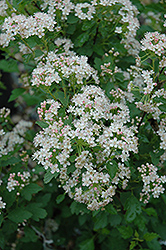Plant Library
Dwarf Ninebark
Physocarpus opulifolius 'Nanus'
Height: 5 feet
Spread: 6 feet
Sunlight:
![]()
![]()
Hardiness Zone: 2a
Other Names: Eastern Ninebark
Description:
A more compact sized shrub with smaller leaves; features masses of attractive white flowers followed by colorful reddish fruit, and interesting peeling papery bark for winter effect; extremely tough and durable, use in massing or for screening
Ornamental Features
Dwarf Ninebark features showy clusters of white flowers at the ends of the branches from late spring to early summer. It has green deciduous foliage. The small serrated lobed leaves turn an outstanding orange in the fall. It produces red capsules from early to mid fall. The peeling tan bark adds an interesting dimension to the landscape.
Landscape Attributes
Dwarf Ninebark is a dense multi-stemmed deciduous shrub with a more or less rounded form. Its average texture blends into the landscape, but can be balanced by one or two finer or coarser trees or shrubs for an effective composition.
This shrub will require occasional maintenance and upkeep, and can be pruned at anytime. It has no significant negative characteristics.
Dwarf Ninebark is recommended for the following landscape applications;
- Accent
- Mass Planting
- Hedges/Screening
- General Garden Use
Planting & Growing
Dwarf Ninebark will grow to be about 5 feet tall at maturity, with a spread of 6 feet. It has a low canopy, and is suitable for planting under power lines. It grows at a medium rate, and under ideal conditions can be expected to live for approximately 30 years.
This shrub does best in full sun to partial shade. It is very adaptable to both dry and moist locations, and should do just fine under average home landscape conditions. It is not particular as to soil type or pH. It is highly tolerant of urban pollution and will even thrive in inner city environments. This is a selection of a native North American species.


